By Bill Kamenjar, Washington Golf Monthly. Photos By Jeff Janas and Jeffrey A. Rendall
|
|
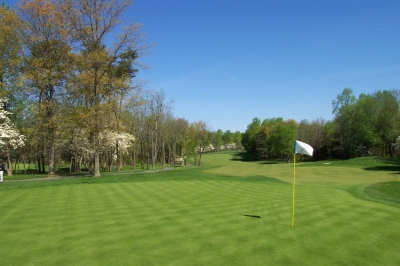 |
| Congressional Gold's par five 6th hole reveals the architect's keen eye for contour. |
WASHINGTON, DC -- It's the 1990s and throughout the Middle Atlantic private golf courses – many considered classics and a surviving link to golf in the early part of the 20th century - are sagging under the strain of a number rounds they were not built to handle. Antiquated drainage and irrigation systems are being taxed. Greens and tees built to the standards of 75 years ago are hard and expensive to maintain. Technology has rendered bunkers meaningless, and members are voicing displeasure with courses time has passed by.
The '90s were good to golf. The game thrived in the public sector, and that didn't go unnoticed in the private sector. Great, new and thoroughly modern courses were being built, and the public menu went from little more than
municipal-level tracks to a smorgasbord of courses as plush and exciting as the private classics only members had access to. In one sense, the esteemed private clubs had to keep up with the public courses. Nowhere was this more evident than around the Capital Beltway.
Bringing a golf course up to date is considerably more difficult than redoing the electrical service or plumbing in the clubhouse. One by one the esteemed clubs of the Washington area realized they needed to invest millions to save their courses and keep their members.
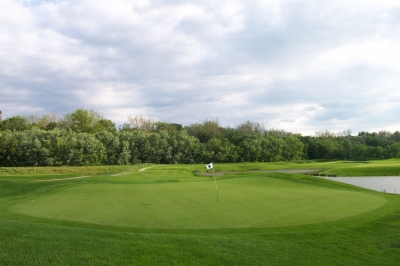 |
| This short par three on Lowes Island's (River) back nine demonstrates Hills' preference for small greens and precise shot-making. |
So they did. And almost all of them started with a phone call to Toledo, Ohio, where Arthur Hills answered the phone.
By the end of 2002, members of Arthur Hills/Steve Forrest and Associates had logged more frequent-flier miles to Washington than their congressman. Since the first phone call from Bethesda Country Club in 1990, the firm has almost hit the cycle in rebuilding Washington's greatest golf courses: Congressional, Burning Tree, Chevy Chase Club, Bethesda, Woodmont, Fairfax and Belle Haven. Next on the hit list is Manor.
The results of subsequent phone conversations has generated such remarks as this from a head PGA golf professional on the changes to his home facility: "It looks awesome, just incredible, it makes me wonder what I ever knew about golf course design strategy in the first place." And this from a prominent member of another club: "Nobody at our club doesn't say it was a 100 percent improvement, nobody." And this from a former golf course superintendent at such ultra-private clubs as Augusta National, Oakmont, Riviera, Congressional and Winged Foot: "He keeps getting work in Washington because people see the results. He's pretty doggoned good."
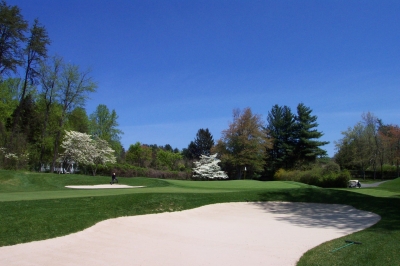 |
| Congressional Gold's par five 14th hole. |
According to Hills, who has quietly turned himself into D.C.'s country club "Renaissance Man," it all began at Bethesda - though he probably would never have imagined it at the time.
"The connection really started through my son Joe (who operates both Waverly Woods and Blue Mash in Maryland) when he moved to the area with his wife," says Hills. "He started checking into opportunities, and we began by working with Dean Graves when he was the superintendent at Bethesda (now the golf course manager at Chevy Chase).
"It was kind of interesting. We were working with the greens chairman there who wanted to make improvements to the golf course. We managed to get together on some things but only to renovate five holes. That went quite well, and the next year we got the OK to do more holes. Then after that we ended up doing the entire golf course. All throughout the process Dean was pushing for things, he was the catalyst to the whole success of the project."
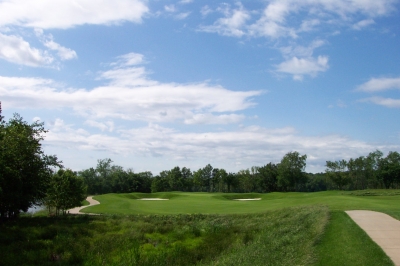 |
| Hills designed Lowes Island's River Course from scratch, but it still has the traditional feel of a much older golf course. |
As it turned out, Graves' multiphase push also turned such a fast lap (the course renovation led to a multimillion-dollar renovation of the clubhouse) that it enabled the golf course architectural firm to speed its way around the Beltway to other esteemed Washington clubs. The team turned its efforts on the Chevy Chase Club, which led to Woodmont, which led to Congressional and so on. In the spring, Hills' most recent renovation at Belle Haven will be unveiled.
Though Hills' name appears most often in golf magazines, the firm is more than a one-man show. The business has grown from a small 1960s outfit operating in the nation's heartland to a team of nearly a dozen traveling to places like Portugal, Sweden and Thailand to sculpt golf courses. Along the way, Hills has latched onto the Washington market. He works with several accomplished designers, including his partner, Forrest, as well as senior architects Drew Rogers, Brian Yoder and Chris Wilczynski. Still, you can't help but think his D.C. portfolio alone stacks right up there with anyone's working in the industry.
"There are so many great golf courses around the Washington metro area," says Rogers, who may have spent as much time as anyone from the firm in D.C. over the period. "But they all differ somewhat. Our character is certainly in a traditional mold, and that has helped us there. It has been an opportunity to showcase our traditional philosophies on those fine golf courses, and that philosophy has complemented much of the existing work. We have not tried to differentiate ourselves through those projects."
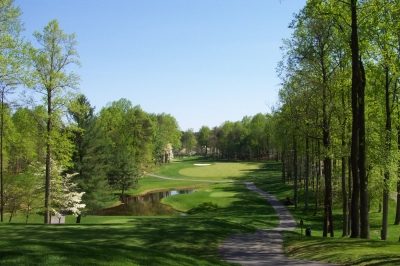 |
| Hills took out many trees from Congressional Gold's par four 8th hole, transforming the hole from barely playable to nearly perfect. |
When all is said and done, the work the firm did in overhauling the Gold Course at Congressional may be looked back upon as the job that solidified its reputation in the region. The Congressional membership is particularly savvy, having brought three major championships to its Blue Course. The Congressional membership roster is an elite group of power brokers from politics, business and the national military.
"The great thing about Mr. Hills is that he is very unassuming, he has no ego and is very easy to work with," says John Lyberger, PGA director of golf at the Bethesda, Md., club. "You know he's in control, but if you have things that you feel will work for your particular environment, he will work with you. There is always a two-way communication. I really like the golf courses where he has come in and reshaped things. He's probably the best as a re-do architect. Of course, his new courses are good, and he ranks up there with a lot of others, but he's also a historian with a great vision into the lay of the land. We now have two championship-level courses to prove it."
All of this is not to say, of course, that the firm doesn't possess the skills needed to create signature designs. In fact, it has been just as successful at leaving trademarks on several venues around the Middle Atlantic. Hills and company are responsible for some starkly original designs as Maryland National, Lighthouse Sound, Blue Mash, Waverly Woods and River Downs in Maryland and the River Course at Lowes Island Club and Heritage Hunt in Virginia. Out of this group, Blue Mash in Olney seems to be the best example of displaying most or all of Hills' design traits all rolled into one. And the awards keep coming for some of these establishments, the most recent of which was at Waverly Woods, named Maryland's Course of the Year for 2002 by the Maryland Golf Course Owners Association.
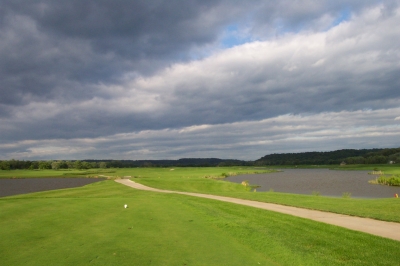 |
| Lowes Island's River Course was built on a near flat piece of land -- it was up to the architect's imagination to provide the excitement, and there's plenty. |
"The neat thing about renovation work is that in the end there are so many more people who are ecstatic about what you've done," Wilczynski says. "It's very meaningful. But in any renovation project, you had better do your homework."
In the case of the renovation of the Chevy Chase Club alone, hundreds of photos were examined before the first branch was cut or the first spade of earth removed.
"When I think of Washington, I think of the Chevy Chase Club," Rogers says. "That's our legacy right there. That's as good as it gets. It's just a charmer. Everything there fits into a historical setting, and when you walk across the golf course, you feel like you are walking across some historic battlefield just in knowing all the people who played a part there. Donald Ross was the original designer. After that came along Harry Colt and Charles Alison and I think even Robert Trent Jones."
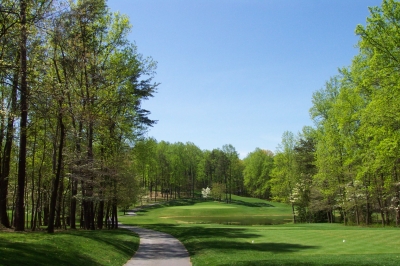 |
| Congressional Gold's par three 11th hole. |
The rehabilitative effort done at Chevy Chase also left a lasting impression on Hills. And this comes from a man who has these golf courses on his historic course renovation project list: Inverness Club in Ohio, Oakland Hills in Michigan, Oakmont in Pennsylvania, and the Country Club of North Carolina in Pinehurst, among others.
"I just think Chevy Chase is a wonderful club," Hills says. "We re-did the greens, tees and bunkers. Our whole objective was to work the golf course's character back to the way it started. It's an absolutely classic golf course.
When we were done, you could hardly tell we had done anything to it. Often times that is the goal when you are working on a classic. More often than not we are not putting the stamp of our design on it, the goal is merely to improve the overall product."
Ask any golf course architect what he prefers - working with a new canvas or tweaking an old - and he will invariably tell you it doesn't matter. That's because there seems to be something very special about filling in the gaps of a Renoir.
"In general, I think you are applying the same principles of design in both instances," says Hills. "You are always looking to capture the strategy of the design and the potential that exists on each individual golf hole. Though in renovation work, you are trying to unearth that or improve the design strategy through enhancements. Sometimes you are trying to create new playing angles. But the same principles of design apply to the same strategic and aesthetic elements. The ultimate goal is to drain a golf course well and to get enough sunlight onto it. We had to take out a lot of trees at Congressional. At Manor, there are the same kinds of concerns. There are shady areas with circulation problems. You are always trying to make the course better and better."
Of course, once Hills and company have wrapped up their part of the process, its up to the crews at the golf courses themselves to preserve those results. According to Eric McPherson, the superintendent of Congressional's Gold Course, Hills also has a way of making those in charge look before they leap. "He could look at a hole and in his mind he knew what he wanted," says McPherson." He could see that hole all the way through to the finish and get everyone's perspective on it. At that point he would turn to me and ask, 'If we build it, do you think you can maintain it?' "
Invariably, the answer has been yes - at Congressional, at Burning Tree, at Fairfax and all the rest. Just look around at the Washington private golf landscape these days. Arthur Hills/Steve Forrest and Associates has quietly helped improve the overall quality of golf in the region. And things have never looked better.
Details:
Please log onto www.TheWGM.com for free monthly subscriptions to Washington Golf Monthly.
| Related Links | Comments on this article? | |
|
Maryland National Golf Club Hollow Creek Golf Club Rocky Gap Resort PB Dye Golf Club in Ijamsville Whiskey Creek Golf Club |
E-mail Jeff Rendall, Editor: jrendall@golftheunitedstates.com |













